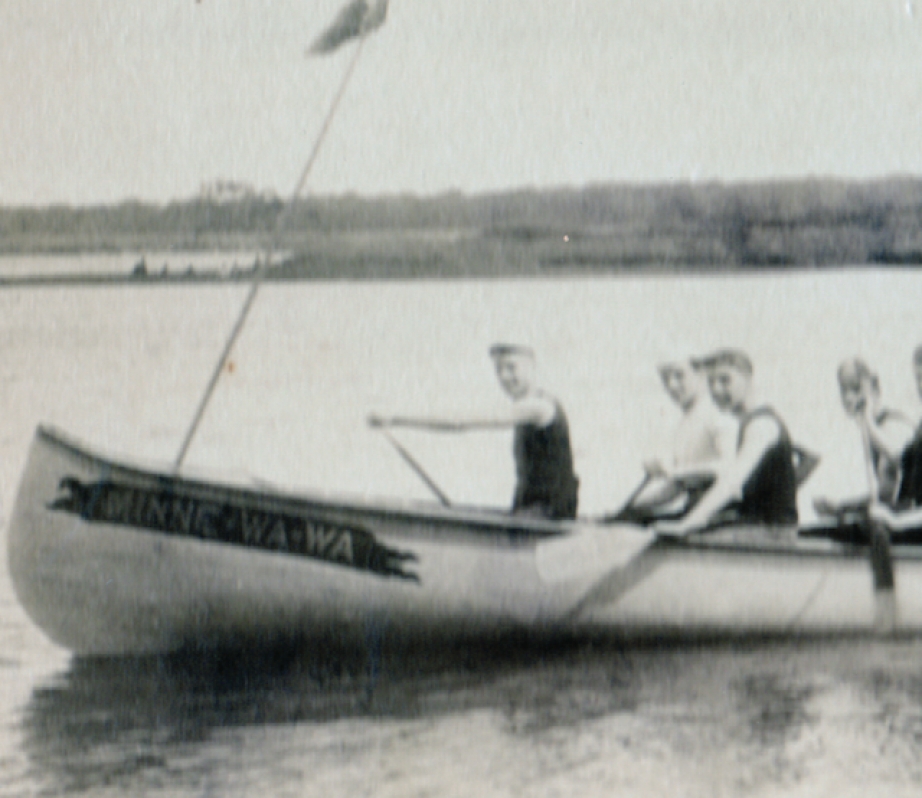One of the great joys of working at The Canadian Canoe Museum is opening the mystery packages that float in over the transom every so often. The most recent of these was a large padded envelope from St. Albert, Alberta, which contained a story that was as thought-provoking as it was sad.
Inside was a matted sepia photograph showing a crew of healthy young men from the Grand Trunk Boating Club in Montreal paddling a 30-foot war canoe called the Minne-wa-wa. It was dated July 2, 1892. There is a mix of characters in the boat— smiling lads in dark singlets showing off their muscles, a couple of aboriginal guys, probably from the Mohawk territory of kahnawake, and even a few older chaps in ties and dress shirts with the sleeves rolled up for regatta action against rival clubs on the mighty St. Lawrence River. There are club caps and fedoras. It’s a crew looking proud and happy after a big win.
The story took a turn when I opened a booklet that came with the photo. What looked like a prize ribbon fell out onto my desk. It said “Minne-wa-wa War Canoe,” but instead of being brightly coloured the rosette on the ribbon was black. And in the program the truth was told.
The crew had paddled from their home boathouse near what is now the base of Montreal’s Champlain Bridge to a regatta downriver at Isle Sainte-Hélène. They triumphed in the race, but on the way home they capsized and six of the crew of 17 drowned. The caption indicated that the photo had been taken about an hour before the accident.
That got me thinking about memory and what we as canoeists choose to remember and share with each other. Who knows what kind of footwear these paddlers had on, or how well suited their clothing was to swimming, or if they could swim at all? And they were certainly not wearing floatation devices (which, of course, was the order of the day for canoeists right up to the late 1960s).
So there was the Minne-wa-wa upset with multiple loss of life in 1892 in Montreal. But, with no apparent appreciation of this unnecessary loss of life, the same thing happened again in 1926 on Balsam Lake in Ontario—war canoe upset, multiple deaths. People then wondered how such a terrible thing could have happened. And then more or less the same thing happened in 1978, when four big canoes upset on Lake Temiskaming resulting in the deaths of 12 boys and a master on a high school canoe trip.
It’s never been so easy for far-flung but like-minded canoephiles to communicate
True, the Temiskaming kids were wearing lifejackets and most succumbed to cold instead of drowning, but at the time people wrung their hands and asked, “How could this have happened?” As though it had never happened before.
All of which reminds me how important it is that people of like minds and common interests communicate, so that the stories—of triumph and of tragedy—can be passed on. Although the Grand Trunk Boating Club is no more, at least four of the original nine clubs that in 1900 formed The Canadian Canoe Assocation—and many more like them—are there for people to join.
Recreational paddlers have provinvial organizations and national groups like Paddle Canada devoted to connecting padllers with other and with the stories of the sport. There are films, television networks and magazines like this one that connect people as well.
And, of course, in today’s electronic universe there are growing and sprawling virtual aggregations of paddlers. They travel the waterways of the web, such as the bulletin board at canoecountry.com or the Wilderness Canoe Association’s lively Canadian Canoe Routes forum, twittering with late-night chatter about everything from bollards to books, safety tips to winter trips and recipes to races. Never before has it been so easy for far-flung but like-minded canoephiles to cimmunicate with one another, and that represents a true strength and great opportunity for a different sport such as our own.
And, when all else fails, there is mail—the venerable Canadian Postal Storage System— where a well-placed package from one paddler to another can pass on an instructive tale or two. Thank you Ron Hollingworth, of St. Albert, Alberta, for taking the time to write.

This article first appeared in the Spring 2009 issue of Canoeroots Magazine.




